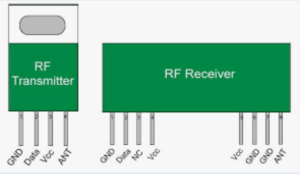
An RF (Radio Frequency) transceiver module is an integrated electronic device that combines both a transmitter and a receiver to enable bidirectional wireless communication. These modules are fundamental to modern wireless systems, facilitating applications ranging from simple remote controls to complex IoT networks. This article explores the architecture, functionality, design considerations, and applications of RF transceivers, providing a detailed overview for engineers, hobbyists, and enthusiasts.
Table of Contents
Toggle1. What is an RF Transceiver Module?
An RF transceiver (transmitter + receiver) operates within the radio frequency spectrum (3 kHz to 300 GHz). It encodes data into electromagnetic waves for transmission and decodes incoming signals for reception. Unlike standalone transmitters or receivers, transceivers allow two-way communication, making them essential for applications like Wi-Fi, Bluetooth, and cellular networks.
Key Features:
- Half-duplex or full-duplex operation:
- Half-duplex: Transmits and receives alternately (e.g., walkie-talkies).
- Full-duplex: Simultaneous transmission/reception (e.g., smartphones).
- Modulation support: ASK, FSK, PSK, OFDM, etc.
- Frequency agility: Operates across licensed/unlicensed bands (e.g., 433 MHz, 2.4 GHz).
- Low power consumption: Critical for battery-powered IoT devices.
2. Internal Components and Architecture
An RF transceiver module comprises several critical subsystems:
A. Transmitter Chain
- Modulator: Converts digital data to analog signals using schemes like FSK (Frequency Shift Keying).
- Oscillator: Generates the carrier wave (e.g. , VCO or crystal oscillator) .
- Power Amplifier (PA): Boosts signal strength for transmission.
- Antenna Switch: Routes signals between Tx and Rx modes.
B. Receiver Chain
- Low-Noise Amplifier (LNA): Amplifies weak incoming signals with minimal noise.
- Demodulator: Extracts data from the carrier wave.
- Filters: Remove out-of-band interference (e.g., SAW filters).
- Mixer: Downconverts RF signals to lower frequencies for processing.
C. Supporting Components
- Microcontroller: Manages protocols (e.g., SPI/UART interfaces).
- Antenna: PCB trace, chip, or external (e.g., dipole, helical).
- Power Management Unit : Regulates voltage for energy efficiency.
3. Frequency Bands and Protocols
Common Frequency Ranges:
| Band | Applications |
|---|---|
| 433 MHz | Remote controls, industrial sensors |
| 868/915 MHz | LoRa, IoT devices (sub-GHz) |
| 2.4 GHz | Wi-Fi, Bluetooth, Zigbee |
| 5 GHz | High-speed Wi-Fi, drones |
Popular Protocols:
- Bluetooth Low Energy (BLE): Short-range, low-power IoT.
- Zigbee: Mesh networking for smart homes.
- LoRaWAN: Long-range, low-data-rate applications.
- Wi-Fi (802.11a/b/g/n/ac): High-speed data transfer.
4. Applications of RF Transceivers
- Internet of Things (IoT): Smart sensors, wearables.
- Telemetry: Remote data collection (e.g., weather stations).
- Consumer Electronics: Wireless mice, keyboards, TVs.
- Industrial Automation: Machine-to-machine (M2M) communication.
- Healthcare: Wireless medical devices (e.g., glucose monitors).
5. Design Considerations
A. Performance Metrics
- Range: Affected by frequency, output power, and antenna gain.
- Data Rate: Higher frequencies (e.g., 5 GHz) enable faster transmission.
- Power Consumption: Critical for battery life; duty cycling can help.
- Interference: Mitigated via frequency hopping (e.g., Bluetooth) or spread spectrum.
B. Modulation Schemes
- ASK (Amplitude Shift Keying): Simple, low-cost (used in car key fobs).
- FSK (Frequency Shift Keying): Robust against noise (e.g., garage door openers).
- OFDM (Orthogonal Frequency Division Multiplexing): High efficiency (Wi-Fi 6).
C. Antenna Design
- Integrated vs. External: Trade-offs between size and range.
- Impedance Matching: Ensures maximum power transfer (typically 50Ω).
D. Regulatory Compliance
- FCC (USA), CE (EU), ISRO (India): Certifications for legal operation.
- SAR (Specific Absorption Rate): Limits RF exposure in consumer devices.
6. Testing and Troubleshooting
Key Tools:
- Spectrum Analyzer: Visualizes signal integrity.
- Signal Generator: Simulates RF environments.
- Network Analyzer: Tests antenna performance.
Common Issues:
- Interference: Solved by changing channels or using shielding.
- Range Limitations: Add a PA or high-gain antenna.
- Data Corruption: Check CRC (Cyclic Redundancy Check) settings.
7. Popular RF Transceiver Modules
- nRF24L01+: 2.4 GHz, SPI interface, popular in Arduino projects.
- HC-12: 433 MHz, 1 km range, UART interface.
- ESP32-C3: Wi-Fi/BLE combo, RISC-V core, IoT-focused.
- LoRa SX1276: Long-range (15+ km), low power.
8. Future Trends
- 5G/6G Integration: mmWave bands for ultra-high-speed links.
- Energy Harvesting: Self-powered sensors using ambient RF energy.
- AI-Driven Optimization: Adaptive modulation and beamforming.
Conclusion
RF transceiver modules are the backbone of wireless communication, enabling innovations across industries. Understanding their design, protocols, and applications empowers developers to create efficient, scalable solutions. As technology evolves, advancements in power efficiency, security, and integration will further expand their capabilities.
- Everything You Need To Know About Limit Switch - May 21, 2025
- Everthing You Should Know About Rheostat - May 20, 2025
- Everything You Need To Know About Reversing Contactor - May 19, 2025






